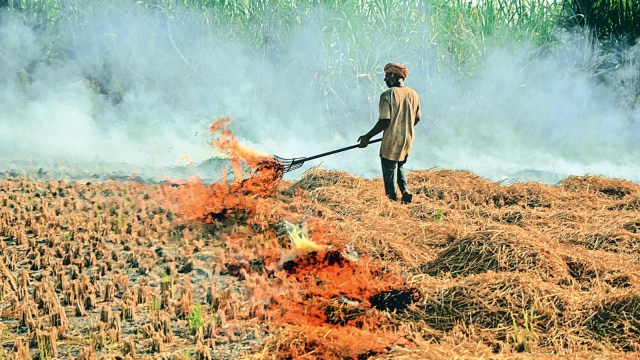In a first, more farm fires in UP than Haryana in a month; Punjab still at top
According to the ICAR-Indian Agricultural Research Institute (IARI) data, between September 15 and October 21 this year, Uttar Pradesh recorded 723 farm fires as compared to 655 in Haryana. Punjab remained at the top of the list with 1,510 cases.
 STUBBLE BURNING is a key source of Delhi’s air pollution in the October-early December period, typically accounting for 20-25 per cent of the pollution, and at times going up to 40 per cent, as per government data.
STUBBLE BURNING is a key source of Delhi’s air pollution in the October-early December period, typically accounting for 20-25 per cent of the pollution, and at times going up to 40 per cent, as per government data. FOR THE first time since 2020, when farm fires began to be tracked centrally, Uttar Pradesh has seen more paddy stubble burning incidents than Haryana.
According to the ICAR-Indian Agricultural Research Institute (IARI) data, between September 15 and October 21 this year, Uttar Pradesh recorded 723 farm fires as compared to 655 in Haryana. Punjab remained at the top of the list with 1,510 cases.
Over the last few years, the focus on implementing guidelines to curb farm fires — including imposing fines, using specialised machinery and incentivising the sale of paddy stubble — has been on Punjab and Haryana due to their high numbers during the paddy harvest season.
The area under paddy cultivation, however, is higher in Uttar Pradesh than in Punjab and Haryana together.
According to experts, the peak stubble burning season is expected to start by the end of next week, and will coincide with Diwali.
Meanwhile, Delhi’s 24-hour average AQI on Tuesday was 327, in the ‘very poor’ category. It is expected to remain very poor in the coming three days as meteorological conditions for dispersal of pollutants are unfavourable.
However, according to the Ministry of Earth Sciences’ decision support system on air quality management, the contribution of stubble burning to Delhi’s AQI is only around 3.2% at present. But a spike is expected, with the forecast stating that by Thursday, the contribution of stubble burning will rise to around 15%. In the past, farm fires have been responsible for up to 40% of the pollutants in Delhi’s air.
STUBBLE BURNING is a key source of Delhi’s air pollution in the October-early December period, typically accounting for 20-25 per cent of the pollution, and at times going up to 40 per cent, as per government data.
A senior scientist at IARI explained that UP has two paddy-burning windows. “The first one, mostly for districts in and around western UP, starts in September and coincides with the trends in Punjab and Haryana. The next window is when districts in eastern UP start burning their stubble. The figures for the state at present mostly show numbers from the areas near Delhi and Haryana,” the scientist said.
Meanwhile, an analysis of paddy stubble burning data by environmental research group Climate Trends showed a clear declining trend in Punjab and Haryana between 2019 and 2023 across the Kharif and Rabi seasons.
Data compiled by the research group showed that farm fires decreased from 95,048 in 2020 to 52,722 in 2023 in Punjab, and from 14,122 in 2019 to 7,959 in 2023 in Haryana.
Farm fires, primarily resulting from agricultural practices such as crop residue burning, introduce significant quantities of particulate matter (PM 2.5 and PM10) in the atmosphere, the study said. “These pollutants, combined with the prevailing wind patterns, travel to Delhi, leading to a sharp increase in AQI. On days without fire incidents, Delhi’s AQI averages 175, which falls in the moderate category,” the study said.







